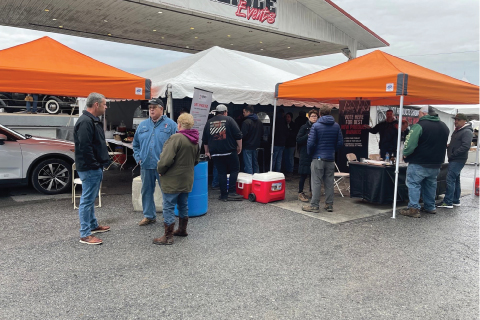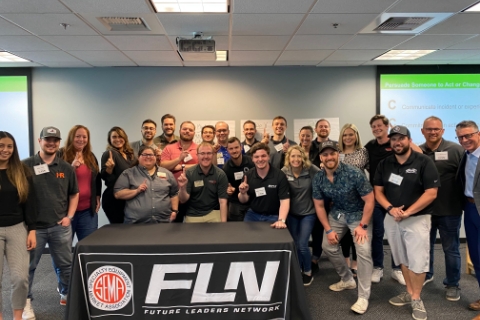SEMA News—March 2020
By Ellen McKoy
 With our industry is reaching new heights, it is now more important than ever to understand our industry and to stay on top of current trends. Download your copy of the SEMA Research report today. With our industry is reaching new heights, it is now more important than ever to understand our industry and to stay on top of current trends. Download your copy of the SEMA Research report today. |
SEMA Research Reveals Retailers Optimistic About Future
As conducting business in the automotive specialty-equipment market becomes increasingly complex and competitive, business owners from all walks of the industry are looking for an edge that will help their businesses thrive and grow. As a result, companies need an increasing amount of information to make sound decisions for both the short- and long-term future.
SEMA recognizes that need. For more than three decades, the association has aimed to meet the need by providing information-related resources in the form of market research reports that enable member companies to seek and make use of data to gain an advantage in operational, sales and marketing strategies.
In the early years, the association mainly published an annual “SEMA Market Study,” which offered a detailed snapshot of the prevailing influences of the day. While the association continues to publish an annual “SEMA Market Report,” research offerings now include a range of other timely topics.
Such is the case with the newly released “SEMA Retail Landscape Report: The Business of Selling to Consumers,” which takes a deep dive into the evolving dynamics playing out in the retail sector of the specialty-equipment market. To gain insights into the compendium of information contained in the study, SEMA Member News recently caught up with Gavin Knapp, SEMA director of market research.
Optimistic Outlook
 Take pride in the success of your business and by utilizing SEMA Research as an opportunity to prosper in the aftermarket industry. Find out more at www.sema.org/research. Take pride in the success of your business and by utilizing SEMA Research as an opportunity to prosper in the aftermarket industry. Find out more at www.sema.org/research. |
The “SEMA Retail Landscape Report” is designed to help specialty automotive retailers understand some of the major strategic challenges and opportunities they face and provide an overview of the business landscape as it currently stands and what may shape its future.
“Even as we see changes going on throughout the supply chain, we know from our research that specialty retailing is still the biggest channel in our industry,” Knapp said. “Obviously, it’s important for everyone to know what’s going on.”
To gather data for the report, SEMA surveyed specialty retailers (both members and nonmembers) who indicated that an essential part of their businesses is devoted to selling customization products directly to consumers. While Knapp acknowledged that there is no “pure” retailer category, he said that facilities such as truck-accessory outlets, four-wheel parts stores, speed shops and jobbers made the cut. Restyling centers and builders/fabricators that primarily sell direct to other businesses did not.
According to the study, the retail outlook is bright. Despite reports that brick-and-mortar stores are doomed to extinction, an impressive 83% of specialty retailers reported stable or increasing sales in 2019, and 70% are expecting an increase in sales this year.
“Retailers are optimistic, and most are doing well,” Knapp said. “Even with all the gloom and doom, the reality of what we often see from the consumer side is actually the opposite.”
But that is not to say that retailers aren’t confronted with an evolving and often challenging landscape.
Obstacle Course
 From a monthly “Industry Indicators Report” to in-depth studies such as the “Young Accessorizers Report,” “Future Trends Report,” “Modern Muscle Car Accessorizer Report” and the “Advanced Vehicle Technology Study,” the findings help keep members up to speed on trends, challenges and opportunities that may affect their businesses. From a monthly “Industry Indicators Report” to in-depth studies such as the “Young Accessorizers Report,” “Future Trends Report,” “Modern Muscle Car Accessorizer Report” and the “Advanced Vehicle Technology Study,” the findings help keep members up to speed on trends, challenges and opportunities that may affect their businesses. |
To quote the study, “Running a specialty auto parts store can be a labor of love.” Essentially, they are businesses that are founded on a passion for automobiles rather than business expertise and acumen—which can leave retailers struggling to sustain profit margins.
“We live in a world where the majority of retail outlets are very small businesses, and that’s not just in our industry; it’s in all retail,” Knapp said. “So if you think about our industry specifically, a lot of retailers exist because they’re passionate about cars and developed a way to turn that passion into a business, but they don’t always come at it from the business angle, and it becomes very challenging.”
The study identifies three primary challenges, and the first is eroding customer loyalty. With vast internet resources at consumers’ fingertips, it’s easy for them to find the products and pricing information they need without ever leaving their homes or offices.
“The fact that people have information overload—and because they can find every part, all the specs and pricing online—means that they’re not locked in to going to their neighborhood store,” Knapp noted. “If you’re running a small business, you’re facing stiff competition.”
And that leads to the second factor: expansion of online sales.
“One of the challenges is morphing into the digital world when that’s not a homegrown talent for someone who’s in business because of a love for cars,” Knapp said. “Online isn’t going to get rid of brick and mortar, but it’s here and likely expanding, so retailers need to develop a strategy to address the challenge of online sales.”
Retailers are also confronted by cost and complexity. Vehicles are harder to modify, and consumer resistance to higher product costs erodes profits.
“Because of increased operating costs, technical complexity, industry innovation and the number of SKUs retailers have to deal with, we find that they are feeling the pressures of cost and complexity,” Knapp said.
But for every challenge, there’s an opportunity to evolve and progress with the times.
Success Strategies
In looking at opportunities to adapt and improve, the study notes that the greatest opportunities lie in providing personalized customer service and maintaining a competitive online presence.
“One of the things we talk about as an opportunity is having an omni-channel strategy,” Knapp said. “That doesn’t mean that you have to be in online sales. It means that you have to know that your customers are looking for information in different places. As many ways as you can get your company in front of them when they’re looking, the greater the chance that they will track back to your store for a purchase.”
Getting customers in the door isn’t enough, however. It’s all about the customer experience—exceeding expectations and offering personalized service not available through online or other brick-and-mortar retailers.
“If retailers try to compete on price, it will be a race to the bottom,” Knapp said. “What they need to do is give the customer a value add, so that coming to their store is better than going someplace else. That means letting them know you’re an expert and giving them ways to touch and feel and better understand the products. Give them reasons—demo days, club meet-ups—that create an experience and make a connection with you.”
The third opportunity is improving operational efficiency, though that can be a challenge for some retailers.
“When you run a small business, it’s easy to get focused on bringing in revenue instead of focusing on productivity and staffing,” Knapp said. “Everybody wants to steal somebody else’s employees—someone who’s already got years of experience. That’s not always a reasonable way to do business.”
As Knapp pointed out, hiring young employees and investing in training is likely to create a better experience for customers and more efficiency in the long run.
The complete “SEMA Retail Landscape Report” runs 104 pages and is divided into three segments: market landscape, business trends and challenges, and opportunities. It is a fascinating read.
“Our emphasis is always for our members to be able to understand what’s going on in the marketplace and with their companies, because ultimately we want to help them sell more products,” Knapp said. “SEMA considers market research one of our core competencies. It’s one of the things that associations do for their members. As Chris Kersting and the SEMA Board have recognized—and our industry has noticed—it’s not easy to find data and information specific to our industry. That’s what we’re here for.”
But providing information is only the beginning. To have value, it must be applied and used to a company’s advantage. For additional information on or about the industry or to contact SEMA staff, visit the market research department’s web pages at www.sema.org/research.








